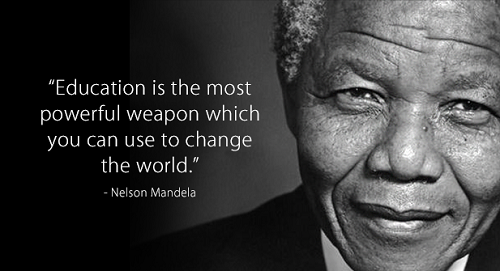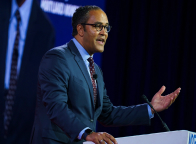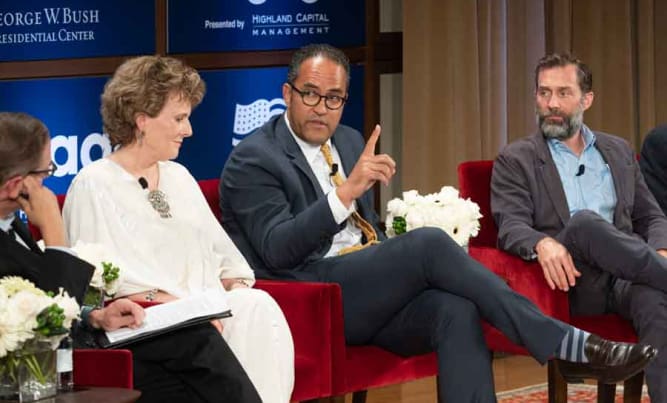Photo: Author generated image with DALL-E, OpenAI’s transformer language model.
The horrific school shooting at an elementary school in Uvalde, Texas restarted conversations on what we should be doing outside our schools to protect our kids on the inside. While we are having this necessary debate, we should also be talking about what we should be doing inside our schools to make sure our kids are ready when its time for them to be outside our education system dealing with the realities of the world.
A recent poll found that three times the number of registered voters rate the performance of the K-12 education system in the United States as poor versus those who rate it as excellent. Another poll found that two-thirds of Americans say public schools are on the wrong track. There is a broad consensus across the electorate that our schools are underperforming, and we need to do more as a nation to ensure that every one of the roughly 63 million school-aged kids in the U.S. has access to high-quality public education.
Unfortunately, the issue of education has gotten caught up in the ongoing American Culture Wars where, to drive clicks and fundraising, the extreme edges of both political parties are manipulating issues like masks in school, critical race theory, book banning, school shootings, and discussions on sexual orientation. This political theater has created a winner-take-all mentality in our political operating system that prevents a real competition of ideas on how to best to serve the educational attainment goals of our children.
Our ability to invest in our human capital and build a workforce of tomorrow, not yesterday, will determine whether the United States can win the New Cold War with the Chinese Government in which we are currently engaged. The winner of this New Cold War will be the global superpower for the rest of this century, and for America to win we need to reboot our thinking on how to educate our kids. That starts with remembering why is education important.
The Importance of Education

Photo: Former President of South Africa, Nelson Mandela views on the importance of education
What does education do? Starting in elementary school, education helps us to develop our potential as individuals. It empowers us with new skills and knowledge that enrich our personal life and everyday . It also helps us to improve our writing skills, critical thinking, logical reasoning, self-confidence, and problem-solving skills.
In a modern society, education is also important because it makes us more self-aware and adept at navigating various life situations, helping us to better understand and interact with the world around us. It equips us with the perspective needed to make informed decisions in a diverse world. Educational attainment gives us a better understanding of other cultures and societies, it helps us to become more tolerant and open-minded, and it increases an individual’s chance to achieve financial security throughout their life.
The Financial Security of a High School Diploma
A kid with some level of formal eduction has better employment opportunities. Someone with a high school diploma or GED is more likely to find a job and earn a livable wage than a kid without one. The necessity of education couldn’t be more clear:
- A high school graduate’s likelihood to get hired rises by 33%, and
- An individual with a high school diploma is likely to earn 40% more income than someone without a degree.
Moreover, attending school up through high school graduation is a prerequisite for entering college. The reason for education is clear.
Benefits of a College Degree

While not everyone is going to pursue higher education, every one of our kids should have the opportunity to pursue formal education and get a college degree. While there is an increasingly public debate about the value of a formal education from a college or university, we already know the benefits higher education provides:
- Earn more money – A person with a bachelor’s degree will make 84% more than somebody with a high school diploma and increase his or her earnings on average by almost $1 million over a lifetime. Depending on the industry, those earning a master’s degree could receive higher salaries than someone with a bachelor’s degree or an associate’s degree in a similar subject.
- Be your own boss – Individuals with a degree from an institution of higher education are twice as likely to launch a small business.
- Improve chances for your kids – 85% of children whose parents graduated from college will also obtain a college degree.
- Become upstanding citizens in everyday life – Degree holders pay far more in taxes over time and are far less likely to rely on public services. They contribute to a stable and secure community.
- Exercise your civic duty – The higher your education level, the more inclined you are to vote.
- Live longer – College graduates tend to smoke less, exercise more, own health insurance, have lower levels of obesity, and live longer than those without degrees.
So why is education important? Education is important because it gives us the skills we need to get good jobs and achieve personal growth. Why is schooling important? It helps us earn more money, and leads to better health outcomes. Doing more as a nation to make education important by ensuring our children have access to high-quality public education not only sets our children up for a successful career, it will ensure America maintains its position in the rest of the world as a global superpower.
Education is a National Security Issue
We can’t explain the importance of education without talking about national security. Not only is a well-trained and educated society necessary for economic growth, but it is also vital to our safety and security. Education is a national security issue. We need a workforce that understands why tech is important. We need our students to be ready to design the next encryption algorithms to protect our military, government, and private sector. We need educated people who can build the rockets to get us to Mars. We need educated people who will design the algorithms for artificial intelligence, chart our future by unlocking the potential of AI’s powers, and accelerate human achievement by transforming industries, governments, and workforces.
These are the reasons why critical thinking education is a national security issue and why schooling is important. We need a technologically advanced workforce that can excel in the next scientific breakthrough yet to be discovered. To build this workforce of tomorrow, we must start at the very beginning, ensuring that early childhood education lays a strong foundation for lifelong learning and development. We can ensure every child gets a quality education and no child gets left behind.
Education Inequality Leads to Income Inequality

Photo: A group of young people in technical vocational training with a teacher.
The importance of education is evident when we look at our economy. Our economy is losing out on trillions of dollars in economic output because our kids can’t keep up academically with kids in other countries. Economists have estimated that the U.S. economy could be almost 4 percent higher than what is currently projected over two decades if American students’ math and science skills were as good as the rest of the world’s.
The Achievement Gap
Just as worrying: disparities in the academic achievement of U.S. students based on their ethnicity, race, family income, and school quality cost billions in unrealized economic gains because a less-educated workforce has difficulty accessing well-paying jobs. This doesn’t just hurt individual families but curbs the economic growth of the country. In the average school district, White students score up to two grades higher than Black students. On family income, the achievement gap between high-income and low-income children continues to widen. The gap is 30 to 40 percent larger among children born in 2001 than among those born twenty-five years earlier.
These inequities represent a disturbing human and economic cost and point to a larger truth about our economy: We have income inequality because we have education inequality. Before the pandemic, less than half of American students could read or do math at grade level. COVID-19 made a tragic problem more so, at a point in time when the stakes couldn’t be higher. This inequality is compounded by the lack of access to technology, infrastructure, and the know-how to use these two things.
The Digital Divide
In this day and age, we are fortunate to have access to educational websites and apps like Duolingo, which offers interactive language learning experiences, and Khan Academy, known for its comprehensive, free learning resources on a wide range of subjects. But, potentially half the country lacks access to high-speed Internet preventing so many of our citizens from having reliable access to these tools. Studies suggest that broadband access has a direct impact on job opportunities and GDP growth. The lowest broadband access and usage are in U.S. counties with the most unemployment.
In this New Cold War with the Chinese Government, the economy of the future is going to be defined by advanced technology. The winner of this race is going to determine whether English and the dollar or Mandarin and the yuan are the language and currency of the global marketplace. If we are going to win then we need our best and our brightest preparing every American child for jobs that don’t exist today.
Improve Teacher Salaries
If we want to improve education in our country, we need to start by taking care of our teachers. We need to competitively pay our teachers so that they can live comfortable lives and focus on what they do best: teaching our kids.
They are the ones in the classroom every day, working tirelessly to contribute to the personal growth of our kids. They are the ones imparting knowledge and skills to our children. They shape the minds of our future leaders, scientists, and artists. And yet, teachers are some of the lowest-paid workers in the country.
Teacher Vs Average College Grad
The average teacher salary in the U.S. is $60,000. When you compare teachers’ salaries to other college graduates, they are woefully underpaid. The average salary of a college graduate in the middle of his or her career is $80,000. That means teachers are paid 25 percent less than the average college graduate. In some states, teachers are paid so little that they qualify for food stamps. It’s no wonder that we have a teacher shortage in this country (for example in Texas, we have over 10,000 K-12 positions unfilled). If we are going to bridge this teacher gap then we need to be creative in how we fund our schools.
How We Fund Education

Photo: Will Hurd at a primary school in the 23rd District of Texas
If we want to attract and retain the best and the brightest to the teaching profession, we need to start by valuing them financially. State and local governments are primarily responsible for funding education, and if they want to show the importance of education then they need to step up and invest in our teachers. Federal, state, and local governments budget $584.9 billion to fund K-12 public education.
- States contribute a total of $274.7 billion to K-12 public education.
- Local governments contribute $269.3 billion.
- The Federal government contributes $40.9 billion
This means the national average for spending on K-12 schools is 3.1% of our Gross Domestic Product (GDP). In our debates on the importance of education, we should be discussing what percentage of our national and state GDPs should be going to build our workforce of tomorrow. But in the meantime, we can’t keep spending money the same way we’ve always done it and expect different results.
Empower Principals
School boards should be working to give principals the authority to arrange compensation for their teachers however they see fit. This would free up principals to be creative in how they attract and retain the best teachers for their students. There is no one-size-fits-all solution to this teacher shortage problem so we need each school to be a laboratory on how to address this challenge.
Encourage Competition in our Education System with School Choice
One of the best ways to improve education in our country is to introduce competition into the system. When there is competition, everyone benefits – especially our kids.
While I am a proud product of public schools, I believe school choice is a great way to encourage competition. It gives parents the power to choose the best school from where their child can get a proper education, regardless of where they live or how much money they have. And it forces schools to up their game in order to attract and retain students. While the charter school movement has been a great success in many urban areas, we need to have an honest debate about what they are and what they are not.
Charter Schools Aren’t Private Schools
A public charter school is a publicly funded, free-to-attend institution administered by independent contractors. Individuals frequently conflate public charter schools with private institutions. Private schools are tuition-based and, unlike public charters, aren’t regulated by the government. Private institutions also tend to have looser regulatory requirements than public charters, which must adhere to a set of regulations established by a board.
Public charter schools are different from traditional public schools in how they are regulated. Traditional public schools follow rules and guidelines set by a school district. Public charter schools still need to follow federal laws and regulations, but instead of being overseen by a district school board, they must follow guidelines that are set up by a separate, independent board. The point is that public charter schools have more flexibility in how they operate than traditional public schools.
Traditional Public Schools Need Flexibility Too
While the debate around the school choice issue has been raging for decades, we should encourage educational competition by increasing the number of successful charter schools. Additionally, school boards and state governments should give school districts and individual traditional public schools the independence to operate the way charter schools do. Instead of having a one-size-fits-all solution within a particular school district, empower a principal in one high school to operate differently from another high school in the same district. Why not allow for a public high school to have the same type of freedom that charter schools have?
Potentially half the country lacks access to high-speed Internet.
The current system is based on a 19th-century model where everyone goes to school for six hours a day, five days a week, and 180 days a year. That model worked well when our economy was primarily agrarian, but today’s economy is based on knowledge and information. We have to prepare our children for the economy of the 21st-century.
Introduce Coding into Middle School
While investing in our teachers and encouraging competition within our educational system have been the subject of complicated debates for years, there’s one strategy that is easy and shouldn’t attract controversy – introduce coding into the standard curriculum of every middle school in the United States of America.
The Language of the Future
Coding is the language of the twenty-first-century economy. If our students can’t speak it, they will be left behind. Our kids need to be fluent in it if they want to be competitive in the global economy. Coding teaches kids problem-solving skills, computer literacy, and at the very least, gives them a better understanding of how technology is shaping our world. It’s an easy and simple way to ensure our kids are ready for jobs that don’t exist today. While introducing coding into our schools seems easy enough to do, it’s not happening.
4% Is Not Enough
In 2021, just 51% of high schools in the U.S. offered some type of computer science class. While this is up from 35% in 2018, given the significance of computing in today’s society, it’s unacceptable that half of the high schools in America lack even a single course.
Understanding the state of computer science education in our middle schools is even harder. Most state education agencies lack reporting on computer science classes taught in middle school. According to the 2021 State of Computer Science Education Report, of the 19 States that had data, only 4% of middle schools in those states offered coding to their students. Every kid in America should have the opportunity to learn this valuable skill.
The Bottom Line
Education is important. It’s time for us to stop fighting about the education reform strategies of the past and start focusing on what will actually move the needle – investing in our teachers, introducing competition into the system, and giving every kid the opportunity to learn coding. These are all common-sense solutions that have been proven to work. It’s time to put our kids first and do what’s best for them.
First time reading? If you want rational takes on foreign policy, politics and technology then sign up below for “The Brief.” It’s a twice a month email on things that aren’t being discussed but should – all in 5 minutes or less. You can register below.






























